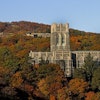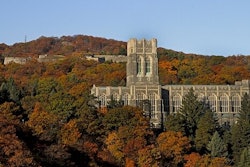ANNAPOLIS, Md.- As U.S. military academies try to recruit more minorities, they aren’t getting much help from members of Congress from big-city districts with large numbers of Blacks, Hispanics and Asians.
From New York to Chicago to Los Angeles, lawmakers from heavily minority areas rank at or near the bottom in the number of students they have nominated for appointment to West Point, the U.S. Naval Academy or the U.S. Air Force Academy, according to an Associated Press review of records from the past five years.
High school students applying to the academies must be nominated by a member of Congress or another high-ranking federal official. Congressional nominations account for about 75 percent of all students at the academies.
Academy records obtained by the AP through the Freedom of Information Act show that lawmakers in roughly half of the 435 House districts nominated more than 100 students each during the five-year period.
But Rep. Nydia Velazquez of New York, chairwoman of the Congressional Hispanic Caucus, nominated only four students, the lowest among House members who served the entire five-year period. Rep. Charles Rangel, whose New York district includes Harlem, was second-lowest, with eight nominations. And House Speaker Nancy Pelosi, whose San Francisco district is 29 percent Asian, was also near the bottom, with 19.
In fact, the bottom 20 House members were all from districts where Whites make up less than a majority.
“It’s beyond my imagination how someone that has the ability to nominate doesn’t do it,” Craig Duchossois said last December at his final meeting as chairman of the Naval Academy’s Board of Visitors.
He noted what an academy appointment means: a free four-year education and a guaranteed job as an officer for at least five years after graduation.
Velazquez, Rangel and Pelosi would not comment or did not return calls.
Academy leaders and some on Capitol Hill do not put all the blame on the politicians, pointing out that some districts might have a shortage of qualified candidates, either because students have not gotten the necessary academic preparation from their struggling schools, they are unaware of the opportunity, or they are uninterested.
But while the burden is ultimately on students to apply, academy leaders and others said elected officials should be doing more to publicize the opportunity by doing such things as visiting schools.
The academies have approached dozens of members of the Congressional Black Caucus and the Congressional Hispanic Caucus to discuss attracting more minority students.
Also, the military recently put together a how-to booklet on minority recruiting and sent it to all congressional offices, said Charles Garcia, chairman of the Air Force Academy’s board of visitors.
In addition, the Air Force Academy has begun flying in congressional staff members from districts with few minority nominations for lessons on recruiting, Garcia said.
“We train them on ‘Here are the things other districts have done that is successful,'” he said. “We are hopeful that will have a huge impact going forward.”
Rangel, Velazquez and most of the rest of the lawmakers who have made the fewest nominations have been among the loudest critics of the wars in Iraq and Afghanistan. Whether that is a factor in their low number of nominations is unclear. Rep. Elijah Cummings, a member of the House Out of Iraq Caucus, nevertheless nominated 128 students over the past five years from his Baltimore district, which is 64 percent Black.
With help from academy officials, Cummings’ staff makes a presentation each spring to schools in his district about how to qualify and apply for an academy nomination. Cummings also designates staffers to respond to questions about the application process, the congressman said through a spokesman.
“There is an openness and a willingness to reach out and help in Cummings’ staff that you don’t see in the others,” said Air Force Maj. Roger Gauret, an instructor in Baltimore Polytechnic Institute’s junior ROTC program. “They work it and they make it happen.”
While lawmakers can offer assistance, Cummings stressed that it is up to students to seek a nomination, just as they are responsible for taking the right math and science courses, participating in extracurricular activities and keeping in shape.
Rep. Maxine Waters, whose district includes heavily Hispanic and Black south Los Angeles and who is among the 20 lowest in nominations, said the wars in Iraq and Afghanistan have made young people in her district question military service. She said her efforts to reach out to high school students have not been successful.
“In the olden days, parents would even say to young African-Americans, ‘You aren’t doing anything. You don’t have a job. Why don’t you join the service?'” said Waters, who has nominated 14 students in the past five years. “They don’t quite do that anymore.”
Dr. James Burk, a professor of sociology at Texas A&M University whose research focuses on the military’s relationship to society, said many minorities have opposed the wars in Iraq and Afghanistan. “Opposition to this war stokes the memory of Vietnam the memory of public debate about minority casualties in Vietnam,” Burk said.
Academy leaders have struggled to make the racial makeup of the military’s officer corps more closely resemble that of its enlisted ranks. The disparity is greatest in the Navy, with minorities making up about 48 percent of the enlisted ranks and just 21 percent of the officer corps.
The academies can cite some recent progress. The freshman class of 1,230 at the Naval Academy in Annapolis, Md., includes 435 students who are Black, Hispanic, Asian American, Native American or part of another minority group. That is about 35 percent, up from 28 percent the year before.
At the U.S. Military Academy at West Point, N.Y., there are 330 minorities in the freshman class of about 1,300, or about 25 percent, up from 22 percent in 2008. The freshman class of 1,376 at the Air Force Academy in Colorado Springs, Colorado, includes 312 minorities, or 23 percent, also a slight increase from the previous class.
House members are limited to nominating students in their districts. Lawmakers can have five students from their districts at each academy at a time, and they can nominate up to 10 students for each vacant seat. That makes it possible to nominate up to 150 students for 15 seats over four years, if all of the seats are vacant.
The bottom 20 members of Congress include Rep. Bobby Rush of Chicago, an Army veteran who has nominated just 12 students in five years. Sharon Jenkins, a spokeswoman for Rush, said he wants to raise awareness in his inner-city district but that people rarely apply for nominations.
“He cares about this,” Jenkins said. “He knows that those numbers are not what he’d like to see.”
Ara Carmel Quinones, an 18-year-old senior at Baltimore Polytech, said she has had her eye on attending the Naval Academy since her freshman year, when she joined junior ROTC at the inner-city magnet school.
Quinones, who emigrated from the Philippines, said the prospect of a prestigious education at no cost is a big enough draw that if she doesn’t get in, she plans to enter the reserves and reapply.
“It’s amazing what they can offer you for free,” she said. “It’s like maybe a Harvard or what one of the best colleges can offer you.”
Associated Press writer Susanne M. Schafer in Fort Jackson, S.C., contributed to this report.


















